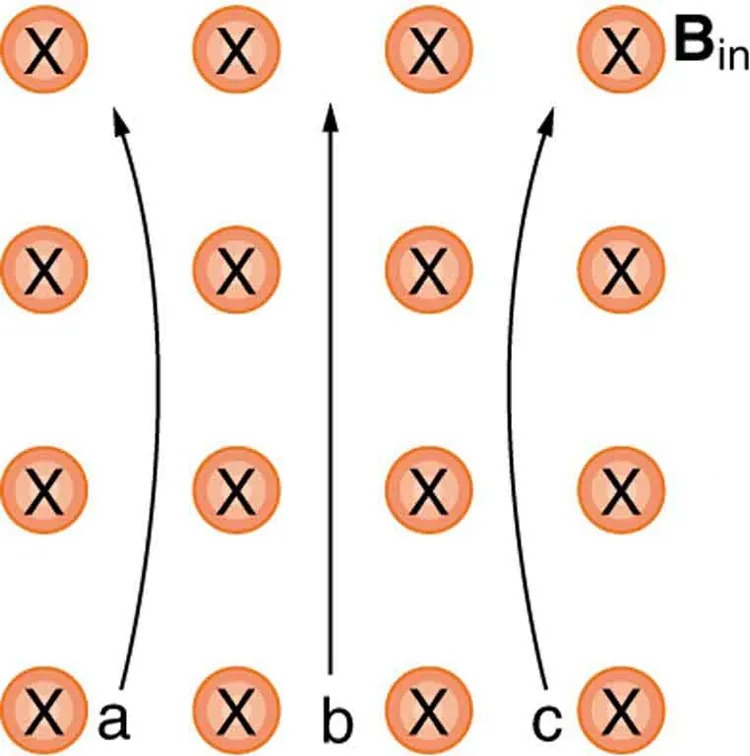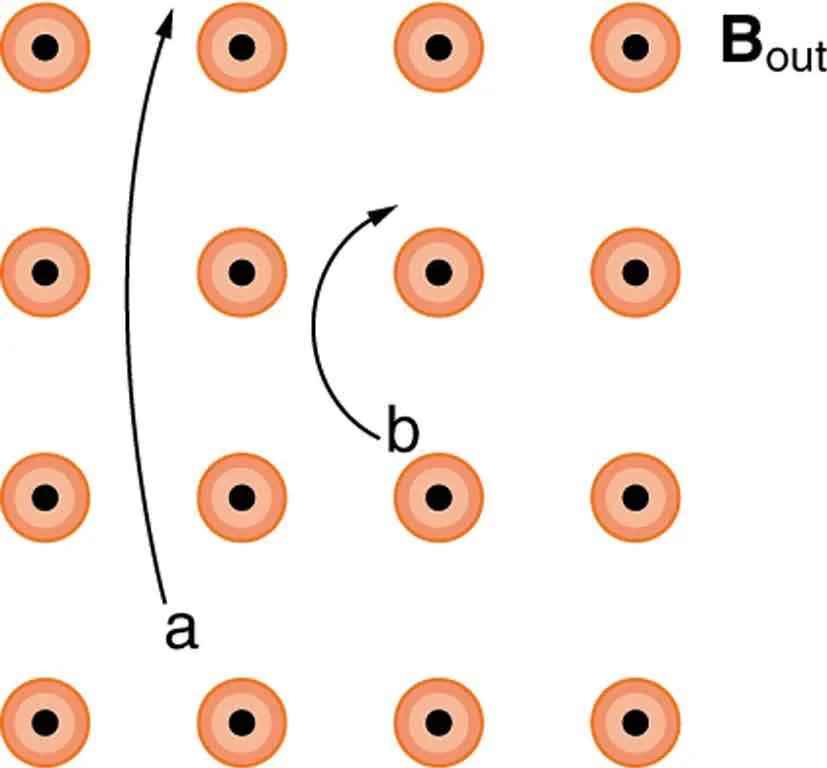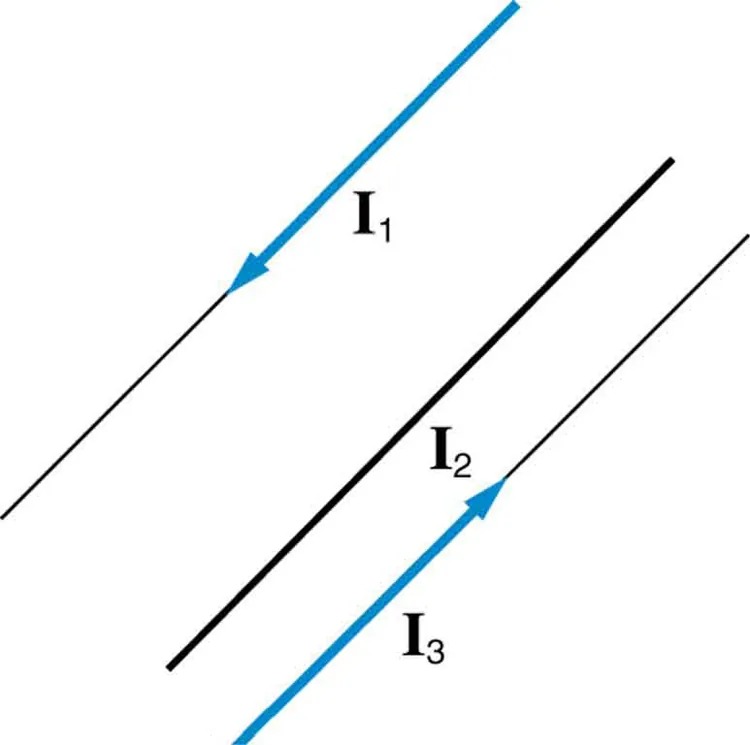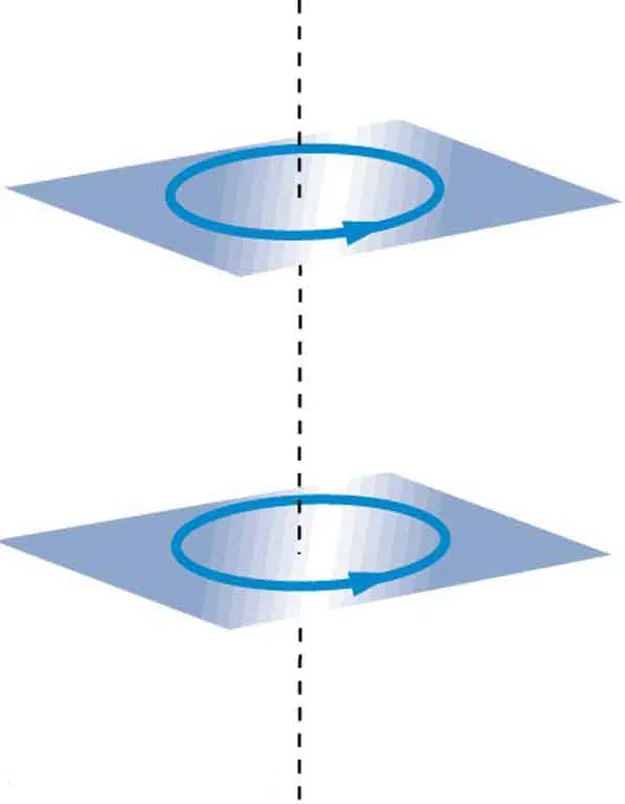Conceptual Questions
Conceptual Questions
17.1 Magnets
- Volcanic and other such activity at the mid-Atlantic ridge extrudes material to fill the gap between separating tectonic plates associated with continental drift. The magnetization of rocks is found to reverse in a coordinated manner with distance from the ridge. What does this imply about the Earth’s magnetic field and how could the knowledge of the spreading rate be used to give its historical record?
17.3 Magnetic Fields and Magnetic Field Lines
- Explain why the magnetic field would not be unique (that is, not have a single value) at a point in space where magnetic field lines might cross. (Consider the direction of the field at such a point.)
- List the ways in which magnetic field lines and electric field lines are similar. For example, the field direction is tangent to the line at any point in space. Also list the ways in which they differ. For example, electric force is parallel to electric field lines, whereas magnetic force on moving charges is perpendicular to magnetic field lines.
- Noting that the magnetic field lines of a bar magnet resemble the electric field lines of a pair of equal and opposite charges, do you expect the magnetic field to rapidly decrease in strength with distance from the magnet? Is this consistent with your experience with magnets?
- Is the Earth’s magnetic field parallel to the ground at all locations? If not, where is it parallel to the surface? Is its strength the same at all locations? If not, where is it greatest?
17.4 Magnetic Field Strength: Force on a Moving Charge in a Magnetic Field
- If a charged particle moves in a straight line through some region of space, can you say that the magnetic field in that region is necessarily zero?
17.5 Force on a Moving Charge in a Magnetic Field: Examples and Applications
- How can the motion of a charged particle be used to distinguish between a magnetic and an electric field?
- High-velocity charged particles can damage biological cells and are a component of radiation exposure in a variety of locations ranging from research facilities to natural background. Describe how you could use a magnetic field to shield yourself.
- If a cosmic ray proton approaches the Earth from outer space along a line toward the center of the Earth that lies in the plane of the equator, in what direction will it be deflected by the Earth’s magnetic field? What about an electron? A neutron?
- What are the signs of the charges on the particles in Figure 17.43?

Figure 17.43 Image from OpenStax College Physics 2e, CC-BY 4.0
Image Description
The image illustrates a concept in electromagnetism with a magnetic field represented by orange circles containing black “X” marks, arranged in a grid pattern. The background is white. The circles are evenly spaced, with three rows and five columns. Three vertical lines are present: two curved lines labeled “a” and “c” and a straight line labeled “b”. These lines are directed upwards, indicating the path of magnetic flux. The label “Bin” is present in the upper right corner, signifying an inward magnetic field.
- Which of the particles in Figure 17.44 has the greatest velocity, assuming they have identical charges and masses?

Figure 17.44 Image from OpenStax College Physics 2e, CC-BY 4.0
Image Description
The image depicts a grid-like arrangement of circular patterns. Each pattern consists of concentric circles: a black dot in the center, surrounded by a pink ring, and another orange ring. The circles are evenly spaced, forming a structured array.
There are two curved arrows labeled “a” and “b” indicating specific directions. The arrow labeled “a” points diagonally upward from the bottom left towards the top left. The arrow labeled “b” points horizontally from left to right at the center of the image.
Additionally, there is text labeled “Bout” located at the top right corner of the image, suggesting an annotation or a description related to the direction of the arrows or arrangement.
- Which of the particles in Figure 17.44 has the greatest mass, assuming all have identical charges and velocities?
- While operating, a high-precision TV monitor is placed on its side during maintenance. The image on the monitor changes color and blurs slightly. Discuss the possible relation of these effects to the Earth’s magnetic field.
17.6 The Hall Effect
- Discuss how the Hall effect could be used to obtain information on free charge density in a conductor. (Hint: Consider how drift velocity and current are related.)
17.7 Magnetic Force on a Current-Carrying Conductor
- Draw a sketch of the situation in Figure 17.29 showing the direction of electrons carrying the current, and use RHR-1 to verify the direction of the force on the wire.
- Verify that the direction of the force in an MHD drive, such as that in Figure 17.31, does not depend on the sign of the charges carrying the current across the fluid.
- Why would a magnetohydrodynamic drive work better in ocean water than in fresh water? Also, why would superconducting magnets be desirable?
- Which is more likely to interfere with compass readings, AC current in your refrigerator or DC current when you start your car? Explain.
17.8 Torque on a Current Loop: Motors and Meters
- Draw a diagram and use RHR-1 to show that the forces on the top and bottom segments of the motor’s current loop in Figure 17.33 are vertical and produce no torque about the axis of rotation.
17.9 Magnetic Fields Produced by Currents: Ampere’s Law
- Make a drawing and use RHR-2 to find the direction of the magnetic field of a current loop in a motor (such as in Figure 17.33). Then show that the direction of the torque on the loop is the same as produced by like poles repelling and unlike poles attracting.
17.10 Magnetic Force between Two Parallel Conductors
- Is the force attractive or repulsive between the hot and neutral lines hung from power poles? Why?
- If you have three parallel wires in the same plane, as in Figure 17.45, with currents in the outer two running in opposite directions, is it possible for the middle wire to be repelled by both? Attracted by both? Explain.

Figure 17.45 Three parallel coplanar wires with currents in the outer two in opposite directions. Image from OpenStax College Physics 2e, CC-BY 4.0
Image Description
The image shows three parallel lines with arrows, representing current flow.
– The first line, labeled as “I1,” is at the top, depicted with a blue arrow pointing downwards.
– The second line, labeled as “I2,” is in the middle, shown as a black line without an arrow.
– The third line, labeled as “I3,” is at the bottom, depicted with a blue arrow pointing upwards.
The blue arrows indicate the direction of current flow for “I1” and “I3,” while “I2” has no direction shown.
- Suppose two long straight wires run perpendicular to one another without touching. Does one exert a net force on the other? If so, what is its direction? Does one exert a net torque on the other? If so, what is its direction? Justify your responses by using the right hand rules.
- Use the right hand rules to show that the force between the two loops in Figure 17.46 is attractive if the currents are in the same direction and repulsive if they are in opposite directions. Is this consistent with like poles of the loops repelling and unlike poles of the loops attracting? Draw sketches to justify your answers.

Figure 17.46 Two loops of wire carrying currents can exert forces and torques on one another. Image from OpenStax College Physics 2e, CC-BY 4.0
Image Description
The image depicts two parallel, blue planes positioned one above the other with a dashed vertical black line running through the center, symbolizing an axis of rotation. On each plane, there is a circular blue arrow indicating a clockwise rotation. The overall visual suggests rotational motion around the vertical axis.
- If one of the loops in Figure 17.46 is tilted slightly relative to the other and their currents are in the same direction, what are the directions of the torques they exert on each other? Does this imply that the poles of the bar magnet-like fields they create will line up with each other if the loops are allowed to rotate?
- Electric field lines can be shielded by the Faraday cage effect. Can we have magnetic shielding? Can we have gravitational shielding?
17.11 More Applications of Magnetism
- Measurements of the weak and fluctuating magnetic fields associated with brain activity are called magnetoencephalograms (MEGs). Do the brain’s magnetic fields imply coordinated or uncoordinated nerve impulses? Explain.
- Discuss the possibility that a Hall voltage would be generated on the moving heart of a patient during MRI imaging. Also discuss the same effect on the wires of a pacemaker. (The fact that patients with pacemakers are not given MRIs is significant.)
- A patient in an MRI unit turns his head quickly to one side and experiences momentary dizziness and a strange taste in his mouth. Discuss the possible causes.
- You are told that in a certain region there is either a uniform electric or magnetic field. What measurement or observation could you make to determine the type? (Ignore the Earth’s magnetic field.)
- An example of magnetohydrodynamics (MHD) comes from the flow of a river (salty water). This fluid interacts with the Earth’s magnetic field to produce a potential difference between the two river banks. How would you go about calculating the potential difference?
- Draw gravitational field lines between 2 masses, electric field lines between a positive and a negative charge, electric field lines between 2 positive charges and magnetic field lines around a magnet. Qualitatively describe the differences between the fields and the entities responsible for the field lines.

